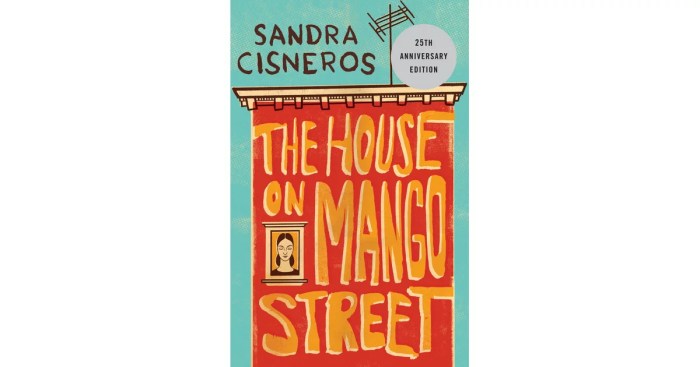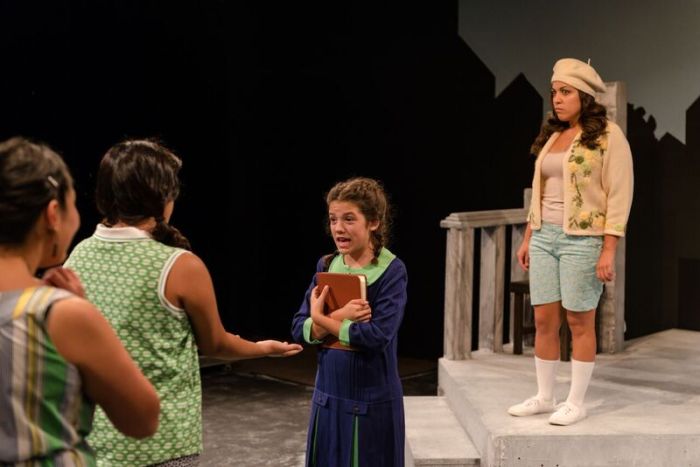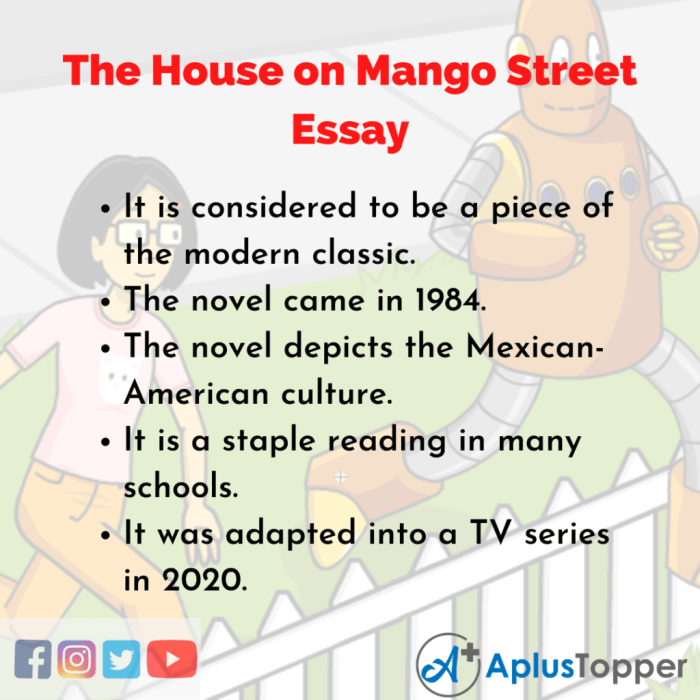Discussion questions for the house on mango street – Discussion questions for “The House on Mango Street” invite readers to delve into a narrative that deftly explores the multifaceted themes of cultural identity, gender oppression, and the complexities of coming-of-age in a marginalized community.
Sandra Cisneros’s poignant novel presents a vivid tapestry of characters whose experiences resonate with readers, prompting critical reflection on the societal challenges that shape individual and collective identities.
Cultural Identity and Heritage

Sandra Cisneros’ The House on Mango Streetdelves into the exploration of cultural identity and heritage through the experiences of Esperanza Cordero, a young Latina girl growing up in a marginalized community. The novel depicts the challenges and complexities faced by individuals as they navigate their cultural roots and forge their own identities.
The Importance of Language and Tradition
Language plays a crucial role in shaping the characters’ sense of self. Esperanza’s struggle to reconcile her Spanish heritage with her American upbringing is evident in her use of language. The novel highlights the power of language to connect individuals to their cultural roots and provide a sense of belonging.
Family and Community Bonds
Family and community are central to the characters’ cultural identity. Esperanza’s extended family provides her with support and guidance, while her friendships with other girls in the neighborhood offer a sense of belonging and shared experiences. The novel emphasizes the importance of these bonds in shaping the characters’ sense of self and their place in the world.
Gender and Oppression
The House on Mango Streetportrays the marginalized experiences of women and the challenges they face in a patriarchal society. Esperanza’s experiences and observations shed light on the limitations imposed on women, highlighting the need for social change and empowerment.
Gender Roles and Expectations
The novel critiques traditional gender roles and expectations that confine women to domestic and subservient roles. Esperanza’s observations of the women in her community, including her mother and neighbors, reveal the societal pressures they face.
Female Empowerment and Resistance
Despite the oppressive circumstances, Esperanza and other female characters exhibit resilience and agency. They challenge societal norms and seek opportunities for personal growth and empowerment. The novel emphasizes the importance of female solidarity and support in overcoming obstacles.
Coming-of-Age and Identity Formation

The House on Mango Streetfollows Esperanza’s journey of self-discovery and identity formation as she navigates the challenges of adolescence. The novel explores the complexities of growing up and the search for a sense of purpose and belonging.
Esperanza’s Growth and Development
Esperanza’s coming-of-age journey is marked by both personal and societal challenges. Through her experiences, she learns about the world around her and her own place within it. The novel depicts the complexities of adolescence, including the search for self-acceptance and the desire for independence.
The Role of Friendships and Mentorship, Discussion questions for the house on mango street
Esperanza’s friendships with other girls in the neighborhood provide her with a sense of belonging and support. She also finds guidance and mentorship from older women, such as her neighbor Sally, who encourage her to embrace her individuality and pursue her dreams.
Poverty and Social Justice
The House on Mango Streetoffers a poignant critique of poverty and the systemic barriers faced by marginalized communities. The novel highlights the social and economic inequalities that perpetuate poverty and limit opportunities.
The Impact of Poverty on Individuals
The novel depicts the harsh realities of poverty and its impact on the characters’ lives. Esperanza and her family struggle with housing instability, food insecurity, and lack of access to education and healthcare. The novel emphasizes the dehumanizing effects of poverty and the need for social change.
Systemic Barriers and Social Justice
Cisneros also explores the systemic barriers that perpetuate poverty, such as racism, classism, and lack of affordable housing. The novel calls for social justice and advocates for policies and programs that address the root causes of poverty.
Structure and Style: Discussion Questions For The House On Mango Street

The House on Mango Streetis notable for its unique structure and style, which contribute to its overall meaning and impact.
Fragmented Narrative and Vignettes
The novel is composed of a series of interconnected vignettes, each offering a glimpse into Esperanza’s life and experiences. This fragmented narrative style allows the author to explore multiple perspectives and themes without being constrained by a traditional plot structure.
Poetic Language and Symbolism
Cisneros employs poetic language and symbolism throughout the novel to create a vivid and immersive reading experience. The use of metaphors, similes, and imagery enriches the text and invites readers to engage with the characters and their experiences on a deeper level.
Common Queries
What is the significance of the house in “The House on Mango Street”?
The house represents both the physical and metaphorical space where the characters navigate their struggles and aspirations, symbolizing the complexities of home and belonging.
How does the novel explore the theme of cultural identity?
The characters’ experiences reflect the challenges and complexities of growing up in a marginalized community, highlighting the interplay of language, tradition, and family in shaping their sense of self.
In what ways does the novel portray gender roles and oppression?
The novel critiques the societal limitations and expectations placed on women, examining the experiences of Esperanza and other female characters to explore the challenges they face.